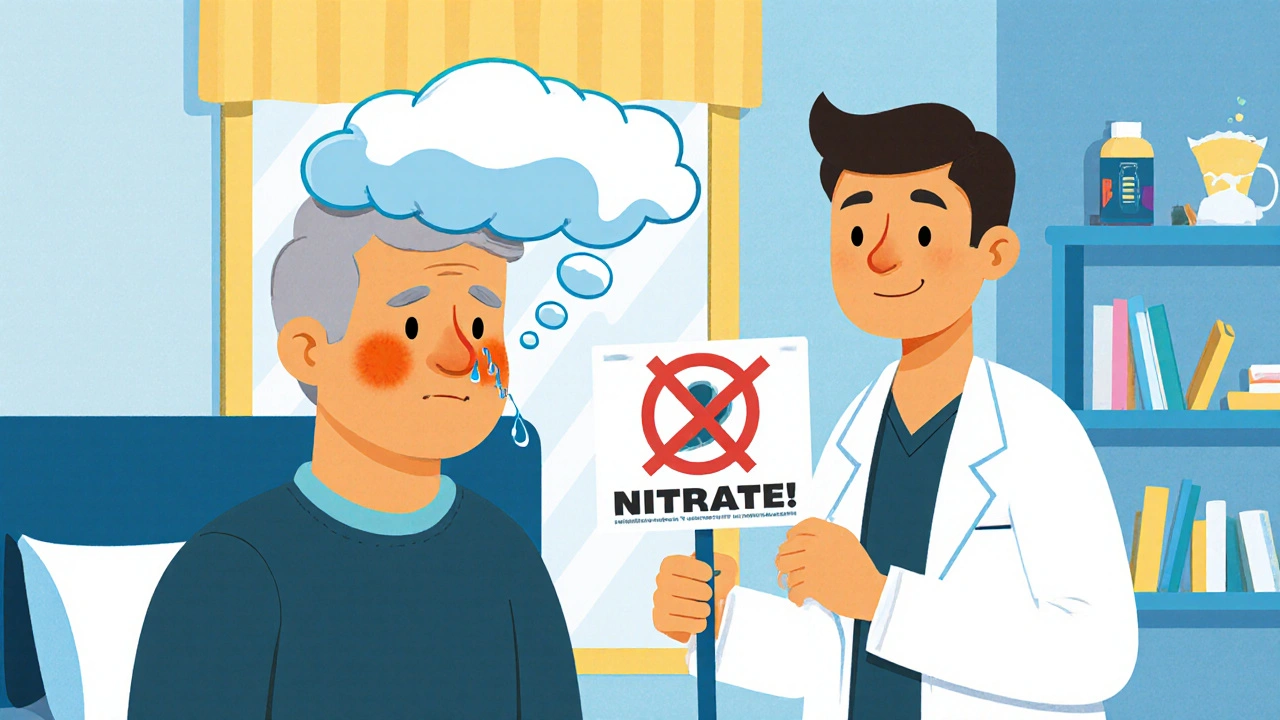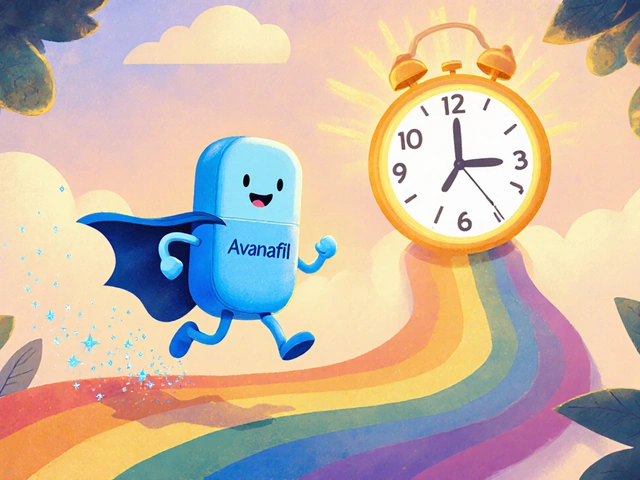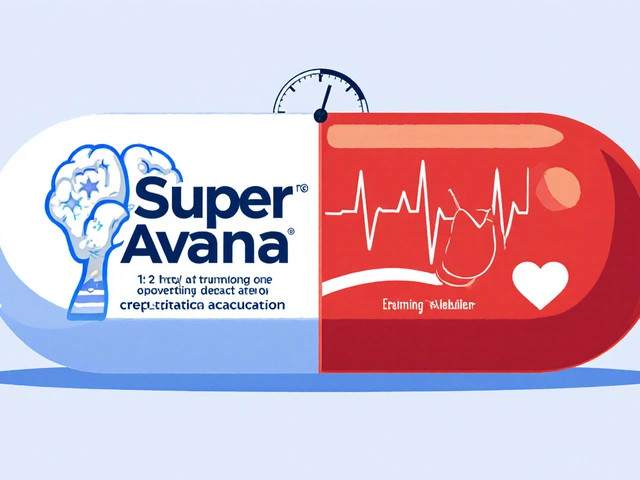Avanafil Safety Checker
Assess Your Avanafil Safety Profile
Answer these questions to determine your personal risk level. Based on FDA data and clinical studies.
DANGER: Do NOT use Avanafil
Combining Avanafil with nitrates can cause severe hypotension. Seek immediate medical help if you experience:
- Severe headache
- Blurred vision
- Difficulty breathing
Consult your healthcare provider before continuing any medications.
Quick Takeaways
- Avanafil works quickly and has a lower overall side‑effect rate than older PDE5 inhibitors.
- Most side effects are mild, short‑lived, and can be managed with simple steps.
- Never combine Avanafil with nitrates or certain blood‑pressure meds; always discuss your full drug list with a healthcare provider.
- If you experience severe symptoms such as prolonged erection or sudden vision loss, seek medical help immediately.
- Alternative ED drugs (sildenafil, tadalafil, vardenafil) may be better suited if specific side effects bother you.
When it comes to treating erectile dysfunction, Avanafil is a fast‑acting PDE5 inhibitor that was approved by the FDA in 2012. It starts working in as little as 15 minutes, which is why many men choose it over older options. But the speed‑up can also trigger nerves: people wonder if the rapid onset means harsher side effects. Below we break down the most common concerns, explain why they happen, and give you practical ways to keep anxiety low while staying safe.
What is Avanafil and How Does It Work?
PDE5 inhibitor is a class of drugs that block the enzyme phosphodiesterase‑5. By doing so, they boost nitric oxide‑driven blood flow to the penis during sexual stimulation. Avanafil’s chemical structure lets it bind to the enzyme quickly and release it slowly, which translates to the fast onset and a relatively short half‑life (about 5‑6 hours). The short half‑life also means the drug clears the system faster, reducing the window for side effects.
Common Side Effects - What to Expect
Clinical trials involving over 2,000 men reported the following side effects for Avanafil at the typical 100‑200mg dose:
- Headache - 10‑12% of users; usually mild and resolves within a few hours.
- Flushing - 8‑10%; a warm, reddish feeling on the face or chest.
- Nasality or a runny nose - 4‑6%; caused by blood‑vessel dilation in the nasal passages.
- Dizziness - 3‑5%; often linked to a brief drop in blood pressure.
- Back pain or muscle aches - less than 3%; more common with longer‑acting PDE5 inhibitors, but still reported.
Serious adverse events (e.g., priapism, sudden vision loss) were rare - under 0.1% - and typically associated with misuse or contraindicated drug combos.
Why Do These Side Effects Occur?
All PDE5 inhibitors share a mechanism that dilates blood vessels not only in the penis but also in other parts of the body. The dilation explains the headache, flushing, and nasal congestion. Because Avanafil’s selectivity for the PDE5 enzyme is higher than that of sildenafil or tadalafil, it tends to spare other PDE isoforms, which is why muscle aches are less common.

Addressing the Most Frequently Voiced Fears
- “What if I get a painful erection that won’t go away?” Priapism (an erection lasting more than 4 hours) is a medical emergency. It occurs in fewer than 1 in 10,000 Avanafil users. If it happens, seek emergency care immediately. Most cases are linked to misuse (taking higher than prescribed doses) or combining the drug with other vasodilators.
- “Can Avanafil damage my heart?” Avanafil can lower blood pressure slightly, but robust studies show no direct cardiotoxicity in men with stable heart disease. The key is to avoid the drug if you’re using nitrates (e.g., nitroglycerin) or have uncontrolled hypertension.
- “I’m worried about sudden vision loss.” Vision issues are linked to drugs that affect PDE6, an enzyme in the retina. Avanafil’s affinity for PDE6 is minimal, so the risk is extremely low. Nonetheless, any sudden visual disturbance warrants immediate evaluation.
- “Will it affect my fertility?” No evidence suggests Avanafil interferes with sperm count or quality. Clinical data up to 2024 show no statistically significant change in fertility parameters.
- “I’m already on blood‑pressure meds; will they clash?” Some antihypertensives, especially alpha‑blockers, can potentiate the blood‑pressure‑lowering effect. Your healthcare provider can adjust dosages or schedule Avanafil to minimize overlap.
Practical Tips to Reduce Anxiety and Manage Minor Side Effects
- Start low, go slow. Begin with the 50mg dose and increase only if needed after a week.
- Take it on an empty stomach. Food, especially high‑fat meals, can delay absorption and increase gastrointestinal discomfort.
- Stay hydrated. Adequate water helps stabilize blood pressure and may lessen dizziness.
- Schedule wisely. If you notice flushing, try taking the pill at a cooler time of day or in a climate‑controlled room.
- Talk to your pharmacist. They can flag hidden nitrate sources (e.g., certain chest pain sprays) and suggest over‑the‑counter remedies for headache.
When Avanafil Might Not Be the Best Fit
Every medication has a sweet spot. Consider these scenarios where another ED drug could be preferable:
- Longer window needed. If spontaneity isn’t guaranteed, tadalafil offers up to 36 hours of activity.
- Cost sensitivity. Generic sildenafil is often cheaper and widely covered by insurance.
- History of muscle aches. Men who experienced significant myalgia with other PDE5 inhibitors may find Avanafil’s lower affinity for PDE11 advantageous.

Comparison Table: Avanafil vs. Other Common PDE5 Inhibitors
| Attribute | Avanafil | Sildenafil | Tadalafil | Vardenafil |
|---|---|---|---|---|
| Onset of action | 15‑30min | 30‑60min | 30‑120min | 30‑60min |
| Duration of effect | 4‑6hr | 4‑5hr | 24‑36hr | 4‑5hr |
| Common mild side effects | Headache, flushing, nasal congestion | Headache, facial flushing, dyspepsia | Headache, back pain, myalgia | Headache, flushing, dizziness |
| Serious side‑effect rate | ≈0.05% | ≈0.1% | ≈0.08% | ≈0.09% |
| Typical starting dose | 50mg | 50mg | 10mg | 10mg |
| Food interaction | Minimal | High‑fat meals ↓ absorption | Minimal | High‑fat meals ↓ absorption |
Talking to Your Healthcare Provider
Bring a concise list to the appointment:
- All prescription meds, over‑the‑counter drugs, and supplements you currently use.
- Any history of heart disease, low blood pressure, or eye disorders.
- Specific concerns you have heard (e.g., “Will it cause headaches?”).
- Preferred dosing schedule (morning vs. evening).
A transparent conversation helps the provider tailor the dose, flag contraindications, and propose lifestyle tweaks that reduce side‑effect risk.
Frequently Asked Questions
Can I take Avanafil with alcohol?
Moderate alcohol (up to two drinks) usually doesn’t affect Avanafil’s efficacy, but heavy drinking can lower blood pressure further and increase the chance of dizziness. Keep intake low on the day you plan to use the medication.
How soon after taking Avanafil will I feel side effects?
Mild side effects such as a headache or flushing often appear within 30‑60 minutes, coinciding with the drug’s peak blood levels. They typically fade within 2‑3 hours.
Is it safe to use Avanafil every day?
Daily use is approved for a 100mg dose, but daily dosing isn’t necessary for most men. Intermittent use reduces cumulative exposure and may lower the chance of persistent headaches.
What should I do if I miss a dose?
Avanafil is taken only when sexual activity is anticipated, so there’s no “missed daily dose.” If you’ve planned a night and forget, take it at least 30 minutes before intimacy. Do not double‑dose.
Can I use Avanafil if I have diabetes?
Yes. Diabetes itself isn’t a contraindication. However, diabetic men often have vascular issues that may affect drug response. Your provider may start at a lower dose and monitor blood‑pressure changes.
Bottom Line
Understanding the why behind each side effect turns vague fear into manageable knowledge. By starting low, staying honest with your healthcare team, and watching for warning signs, you can enjoy Avanafil’s rapid benefits while keeping risks in check. If a particular side effect keeps nagging you, explore the alternatives in the table above - one of them will likely align better with your body and lifestyle.



OKORIE JOSEPH
October 15, 2025 AT 19:43Don’t worry about the headache just take the pill and stop overthinking
Nikita Warner
October 20, 2025 AT 10:50It is advisable to initiate therapy with the lowest approved dose, typically 50 mg, and assess tolerance before any escalation. Monitoring blood pressure prior to administration can help identify patients at risk of hypotensive episodes. Should a mild headache occur, hydration and an over‑the‑counter analgesic such as acetaminophen are usually sufficient. Nasal congestion often resolves spontaneously within a few hours; a saline spray may provide symptomatic relief. In the unlikely event of priapism lasting beyond four hours, emergency medical attention is mandatory. Patients concomitantly taking nitrates must abstain from Avánafil due to profound vasodilation. A concise medication list, including over‑the‑counter supplements, should be reviewed with the prescribing clinician. These steps collectively minimise adverse effects while preserving therapeutic benefit.
Jonathan Lindsey
October 25, 2025 AT 01:56Navigating the landscape of erectile dysfunction pharmacotherapy often feels like a grand academic symposium, where each molecule parades its own virtues amid a chorus of side‑effect expectations. Avanafil, with its rapid onset of action, positions itself as the sprinter of the PDE5 inhibitor family, arriving on the scene in as little as fifteen minutes, a statistic that many patients find both impressive and, admittedly, intimidating. One might wonder whether such haste translates into a heightened risk profile, but clinical data consistently demonstrate a side‑effect incidence comparable to, if not lower than, its more venerable counterparts. The most frequently reported adverse events-headache, flushing, and nasal congestion-are generally mild, transient, and amenable to simple self‑care measures. For instance, a modest increase in fluid intake can alleviate dizziness by stabilising intravascular volume, while a brief hiatus from high‑fat meals reduces gastrointestinal discomfort. Moreover, the drug’s short half‑life, approximately five to six hours, serves as a protective buffer, limiting systemic exposure and consequently diminishing the window for serious complications. It is also worth noting that Avanafil’s selectivity for the PDE5 isoform reduces off‑target interactions, thereby sparing the retinal PDE6 enzyme and mitigating concerns regarding sudden vision loss. Nevertheless, the lingering myth that all PDE5 inhibitors pose a uniform cardiovascular threat persists, despite robust studies indicating no intrinsic cardiotoxicity in patients with stable heart disease when nitrates are avoided. In practice, the most prudent approach involves a thorough medication reconciliation, especially scrutinising for hidden nitrate sources such as certain topical sprays. Should a patient experience an unexpected priapism, the recommended course of action remains unequivocal: seek emergency care without delay, as prolonged ischemia can result in irreversible tissue damage. While the incidence of such events is under one in ten thousand, complacency is never justified. From a cost perspective, generic sildenafil often undercuts Avanafil, but insurance formularies and patient preference for a rapid onset may justify the premium. Clinicians should also consider individual patient lifestyle: those desiring spontaneity may favour Avanafil, whereas individuals preferring a longer therapeutic window might opt for tadalafil’s extended coverage. Ultimately, the decision matrix integrates pharmacokinetics, side‑effect tolerance, financial considerations, and personal convenience. By adhering to a “start low, go slow” titration strategy, patients can comfortably navigate the initial adjustment phase, monitoring for any emerging concerns. In summary, Avanafil offers a compelling blend of efficacy and tolerability, provided that prescribers and patients engage in open dialogue and vigilant self‑monitoring.
steve wowiling
October 29, 2025 AT 16:03Life’s little mysteries, like why a pill works faster than a coffee, invite us to ponder the fleeting nature of desire itself; perhaps the rush of sensation mirrors the fleeting anxiety we feel about side effects. In the grand theater of intimacy, Avanafil is merely a prop, not the playwright. If the script calls for a cameo, a single dose may suffice, and the audience will applaud. Otherwise, the drama of over‑thinking becomes the real performance. So, breathe, and let the chemistry do its work.
Warren Workman
November 3, 2025 AT 07:10While the mainstream discourse glorifies Avanafil’s rapid pharmacodynamics, a deeper analysis of its intracellular cGMP modulation reveals a paradoxical attenuation of endothelial nitric oxide synthase activity in certain phenotypes. This nuance is often obscured by marketing narratives that prioritize market share over mechanistic fidelity. Moreover, the lexicon of “mild side effect” masks a spectrum of subclinical hemodynamic fluctuations that warrant closer scrutiny. In essence, the drug’s kinetic profile is not a panacea but a variable that must be contextualised within each patient’s vascular milieu.
Kate Babasa
November 7, 2025 AT 22:16Indeed, the complexities you outlined merit a balanced perspective; however, it is equally important to acknowledge that the majority of clinical trials have demonstrated tolerable safety margins-yet, as you rightly point out, individual variability persists; therefore, a collaborative approach between patient and provider remains essential.
king singh
November 12, 2025 AT 13:23Sounds like a solid plan, good luck.
Adam Martin
November 17, 2025 AT 04:30Oh, absolutely, because “good luck” is the cornerstone of evidence‑based medicine; let’s just wish our way through pharmacology while ignoring the decades of rigorous research that inform dosing strategies, shall we? In reality, a methodical review of the therapeutic window, coupled with patient‑specific risk assessment, is far more reliable than any casual expression of hope. Nevertheless, I appreciate the optimism, even if it borders on the naïve, and I’ll gladly append a detailed protocol to ensure we’re not merely winging it. After all, success isn’t accidental-it’s engineered.
Ryan Torres
November 21, 2025 AT 19:36Everyone’s pushing Avanafil like it’s a miracle, but have you considered the hidden nanotech in the pills? The pharma giants are definitely collecting our biometric data every time we swallow something, and the side‑effects are just a front for deeper surveillance 👀💊. Keep your eyes open and your water bottle full.
shashi Shekhar
November 26, 2025 AT 10:43Sure, the nanotech conspiracy is as credible as the placebo effect, and it distracts from the simple fact that occasional headaches are just part of the drug’s pharmacologic profile. No need to over‑complicate it.
Marcia Bailey
December 1, 2025 AT 01:50Great summary, everyone! If you experience a mild headache, try a glass of water and a short walk – it often helps 😊. Remember to keep a medication log so you can spot patterns and discuss them with your doctor. Staying proactive makes the whole process smoother.
Lucy Pittendreigh
December 5, 2025 AT 16:56People should read the warnings and stop ignoring basic safety they’re basically reckless
Gary Giang
December 10, 2025 AT 08:03From a cultural standpoint, many societies view sexual health as a private matter, yet the introduction of fast‑acting agents like Avanafil has sparked open conversations that were once taboo. This shift encourages individuals to seek professional advice rather than rely on folklore remedies. By normalising dialogue, we reduce stigma and promote informed choices.
Crystle Imrie
December 14, 2025 AT 23:10Such melodramatic warnings only frighten the uninformed.